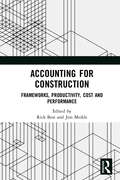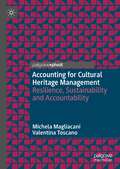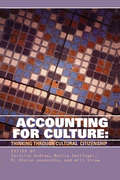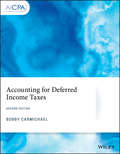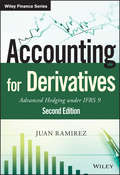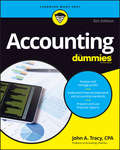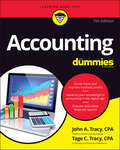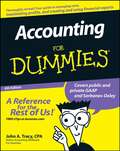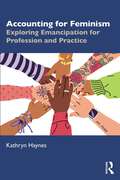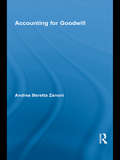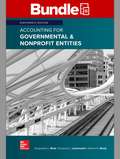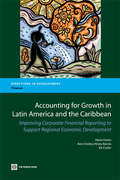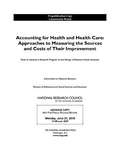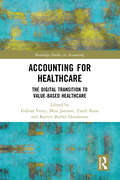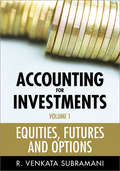- Table View
- List View
Accounting for Construction: Frameworks, Productivity, Cost and Performance
by Rick Best Jim MeikleAccounting for Construction follows on from Measuring Construction, edited by the same team. It extends the coverage of some of the material in the first volume and expands the range of related topics to include, inter alia, shadow economies, accounting for informal construction and the treatment of the built environment sector in national accounts. Taken together, the two volumes collate a range of topics that are only addressed, if addressed at all, in occasional academic papers and the publications of bodies such as national statistical offices and the World Bank. Accounting for Construction presents international examples from the UK, Australia and New Zealand and from both academic and professional contributors. This book is essential reading for all researchers and professionals interested in construction economics, construction management, and anyone interested in how the construction industry affects the global economy in ways previously under-represented in the literature.
Accounting for Cultural Heritage Management: Resilience, Sustainability and Accountability
by Michela Magliacani Valentina ToscanoThe transformative role of culture, its ability to create value for the benefit of current and future generations, is widely recognized by academics of many disciplines, professionals and policymakers. Notwithstanding, how culture can be a driving force for economic growth, a source of welfare and tools for social inclusion, still deserves to be investigated at various levels, starting with local communities. This book attempts to explain the relevance of accounting knowledge for managing cultural heritage by sustainable, resilient, accountable organizations, regardless of their public or private institutional form. This book aims at understanding the role of cultural heritage in the economy, in society and in facing the new challenges deriving from the enactment of the UN Sustainable Development agenda, as well as the pandemic emergency from COVID-19. It adopts a managerial accounting studies approach to provide answers that can be applied in any organizational context. The results achieved from the field research are critically discussed under the theoretical frameworks referring to the theory of value and its creation. From the findings and their discussion, a conceptual model based on empiricism is proposed for managing cultural heritage of communities under sustainable perspective, even in times of crisis. It will be essential reading for academics and students of cultural heritage management, sustainability and crisis management in organisations.
Accounting for Culture: Thinking Through Cultural Citizenship (Governance Series)
by Caroline Andrew Monica Gattinger M. Sharon Jeannotte Will StrawMany scholars, practitioners, and policy-makers in the cultural sector argue that Canadian cultural policy is at a crossroads: that the environment for cultural policy-making has evolved substantially and that traditional rationales for state intervention no longer apply. The concept of cultural citizenship is a relative newcomer to the cultural policy landscape, and offers a potentially compelling alternative rationale for government intervention in the cultural sector. Likewise, the articulation and use of cultural indicators and of governance concepts are also new arrivals, emerging as potentially powerful tools for policy and program development. Accounting for Culture is a unique collection of essays from leading Canadian and international scholars that critically examines cultural citizenship, cultural indicators, and governance in the context of evolving cultural practices and cultural policy-making. It will be of great interest to scholars of cultural policy, communications, cultural studies, and public administration alike.
Accounting for Current Assets
by William J. Bruns Jr.An introduction to accounting for current assets: receivables, inventories, and other current assets. Included are discussions of FIFO, LIFO, average cost, and explanation of accounting for manufactured inventories. To be assigned with cases on inventory valuation as an introduction to current assets.
Accounting for Decision Making and Control
by Jerold L. ZimmermanAccounting for Decision Making and Control provides students and managers with an understanding appreciation of the strengths and limitations of an organizations accounting system, thereby allowing them to be more intelligent users of these systems. Zimmerman provides students with a framework for understanding accounting systems and a basis for analyzing proposed changes to these systems. <p><p> Consistent with prior editions, the goal of the new 10th edition of Zimmerman strives to demonstrate to students that Managerial Accounting is an integral part of the firm’s organizational architecture, not just an isolated set of computational topics.
Accounting for Deferred Income Taxes (AICPA)
by Bobby CarmichaelA complicated accounting model, FASB ASC 740 has been around for a while. But the rules are becoming more challenging as businesses become more complex. This book incorporates the new tax rates and other impacts of the Tax Cuts and Jobs Act and will assist you in understanding FASB ASC 740, Income Taxes, and how it establishes guidelines for accounting for income taxes, including income tax expense, classification of deferred tax accounts, and related disclosures.Key topics include: Principles of FASB ASC 740 Income tax expense and deferred tax liabilities and assets Valuation allowances Proper documentation of deferred income taxes in the work papers Required disclosures within the financial statements
Accounting for Derivatives
by Juan RamirezAccounting for Derivatives: Advanced Hedging under IFRS is a comprehensive practical guide to hedge accounting. This book is neither written by auditors afraid of providing opinions on strategies for which accounting rules are not clear, nor by accounting professors lacking practical experience. Instead, it is based on day-to-day experience, advising corporate CFOs and treasurers on sophisticated hedging strategies. It covers the most frequent hedging strategies and addresses the most pressing challenges that corporate executives find today.The book is case-driven with each case analysing in detail a real-life hedging strategy. A broad range of hedging strategies have been included, some of them using sophisticated derivatives.The objective of this book is to provide a conceptual framework based on the extensive use of cases so that readers can create their own accounting interpretation of the hedging strategy being considered. Accounting for Derivatives will be essential reading for CFOs, internal auditors and treasurers of corporations, professional accountants as well as derivatives professionals working at commercial and investment banks.Key feature include:The only book to cover IAS39 from the derivatives practitioner's perspectiveExtensive real-life case studies to providing essential information for the practitionerCovers hedging instruments such as forwards, swaps, cross-currency swaps, and combinations of standard options as well as more complex derivatives such as knock-in forwards, KIKO forwards, range accruals and swaps in arrears.Includes the latest information on FX hedging and hedging of commodities
Accounting For Dummies
by John A. TracyLearn the basics of practical accountingFeaturing the latest information on accounting methods and standards, this guide shows you how to avoid accounting fraud, minimize confusion, maximize profits, and make sense of accounting basics. You'll quickly understand how to manage inventory, report income and expenses for public or private companies, evaluate profit margins, analyze business strengths and weaknesses, and manage budgets for a better bottom line.With 25 percent new content including updated information on small and large business reporting standards, international accounting standards, and preventing financial reporting fraud, Accounting For Dummies continues to be an excellent resource for those studying accounting. The separate accounting and financial reporting standards for private/small businesses versus public/large businesses (Little GAAP vs. Big GAAP)The internationalization of accounting standardsThe rise in restatements of previously issued financial reports by public corporations, and how revisions of previously reported earnings impact investorsThe increasing focus on preventing financial reporting fraud and the expanded role and responsibility of the CPA auditorAccounting problems with stock optionsThe "unaccounted for" cost of employee pensions and retirement health care costs, in both the private and public sectorsExpanded coverage of small business accountingUpdated resources and websitesThe information in Accounting For Dummies is valuable for anyone studying or working in the fields of accounting or finance.
Accounting For Dummies
by John A. Tracy Tage C. TracyDemystify your financial statements and figure out what your accountant is talking about with this straightforward roadmap to the world of accounting Few skills are as useful as a basic understanding of accounting language. And with the right resources, learning the language of business can be intuitive, empowering, and fun. Accounting For Dummies is the perfect place to start, whether you're operating a small business, just need help managing the family budget, or you're a rising star in corporate America. It's a financial blueprint for the everyday person, easy-to-understand, and full of practical advice. You'll learn the basic ABC's of accounting, how to read and understand financial statements, create best in class budgets & forecasts, craft profitable business plans, take control of your own finances, gain insight on how companies get money from investors and banks, and avoid common money mistakes that trip up even the best of us. You'll also find out how to: Diagnose the financial health of your business and make a realistic plan to grow your company Improve your own or your family's money situation with sound financial planning and understanding Understand each of the three basic financial statements and what they say about a company's past, present, and future Enhance your knowledge of how accounting functions and operates in today's digital age and cloud-based world As a useful tool for business or as a guide to your personal finances, nothing compares to accounting mastery. And once you've nailed the basics, you'll wonder how you ever lived without this universal and beautiful language.
Accounting For Dummies, 4th Edition
by John A. Tracy CPALearn the basics of practical accounting easily and painlessly with Accounting For Dummies, 4th Edition, which features new information on accounting methods and standards to keep you up to date. With this guide, you can avoid accounting fraud, minimize confusion, maximize profits, and make sense of accounting basics with this plain-English guide to your accountant's language. Understand how to manage inventory, report income and expenses for public or private companies, evaluate profit margins, analyze business strengths and weaknesses, and manage budgets for a better bottom line.
Accounting for Employee Stock Options
by Mark T. BradshawEmployees who have been granted stock options have the right to purchase shares of their company's stock at a specified price within a specified time period. The accounting for such employee stock options has been a controversial and complex topic for decades. The debate has continued to the present time because of the high visibility of company executives who have made fortunes under their stock option programs. This note chronicles the history and debate surrounding the rules for stock options accounting and provides a simple, instructive example of accounting entries for fixed stock option grants.
Accounting for Feminism: Exploring Emancipation for Profession and Practice
by Kathryn HaynesAlthough gender challenges in accounting are widely acknowledged, research often addresses the position of men and women in relation to various issues, without necessarily challenging the underlying structures and social constructions of gender. In contrast, this book takes a much more overtly feminist position, informed by feminist theory, feminist methodology and feminist activism, to challenge these constructs and resulting inequalities. The book addresses contemporary global feminisms and their potential emancipatory implications for accounting, as a profession and as a tool or technology.It explores feminist theorisations of accounting, offering new insights into their relevance, and provides a rich theoretical and practical resource to advance knowledge in the discipline and stimulate further interdisciplinary research. Rather than being issue driven with chapters organised to address particular concerns that relate to gender and accounting, such as parenthood, career progression, accountability, etc., the structure of this book is such that the feminist theoretical position is the starting point for each chapter. The book highlights the range of ways that feminism, in its various forms and from numerous theoretical perspectives, can contribute to an understanding of the challenges relating to gender, race and class occurring within accounting, and the ways of overcoming them.In this way, the book provides an integrated discussion of feminist theories and the emancipatory potential of applying them to accounting that will appeal to readers whatever their orientation to feminism.
Accounting for Financial Instruments: A Guide to Valuation and Risk Management
by Emanuel Camilleri Roxanne CamilleriAccounting for Financial Instruments is about the accounting and regulatory framework associated with the acquisition and disposal of financial instruments; how to determine their value; how to manage the risk connected with them; and ultimately compile a business valuation report. Specifically, the book covers the following topics, amongst others: Accounting for Investments; Bills of exchange; Management of Financial Risks; Financial Analysis (including the Financial Analysis Report); Valuation of a business (including the Business Valuation Report) and Money laundering. Accounting for Financial Instruments fills a gap in the current literature for a comprehensive text that brings together relevant accounting concepts and valid regulatory framework, and related procedures regarding the management of financial instruments (investments), which are applicable in the modern business world. Understanding financial risk management allows the reader to comprehend the importance of analysing a business concern. This is achieved by presenting an analytical framework to illustrate that an entity’s performance is greatly influenced by its external and internal environments. The analysis of the external environment examines factors that impact an entity’s operational activities, strategic choices, and influence its opportunities and risks. The analysis of the internal environment applies accounting ratio analysis to an entity’s financial statements to examine various elements, including liquidity, profitability, asset utilisation, investment, working capital management and capital structure. The objective of the book is to provide a fundamental knowledge base for those who are interested in managing financial instruments (investments) or studying banking and finance or those who wish to make financial services, particularly banking and finance, their chosen career. Accounting for Financial Instruments is highly applicable to both professional accountants and auditors and students alike.
Accounting for Frequent Fliers
by Susan S. Harmeling William J. Bruns Jr.Airline frequent flier programs offer members the opportunity to earn free flights by accumulating mileage. Accounting and reporting the obligations of airlines and the cost of frequent flier programs raises difficult measurement issues. In 1991, the U.S. Securities and Exchange Commission began to require airlines to disclose the number of free flights program members took. The case allows estimates of the cost and obligations of the United Air Lines program.
Accounting for Global Dispersion of Current Accounts
by Yongsung Chang Sun-Bin Kim Jaewoo LeeAccounting for Global Dispersion of Current Accounts
Accounting for Goodwill (Routledge Studies in Accounting #6)
by Andrea Beretta ZanoniThis book provides an illuminating analysis of Internally Generated Goodwill from a strategic point of view. The author launches his strategic analysis from a foundational understanding of Internally Generated Goodwill as determined largely in relationship to intangible resources and competitive differentials. Arguing that intangible resources are at the origin of competitive differential--and accordingly at the origin of the achievement of economic profit--the author shows how Internally Generated Goodwill can be considered as the economic expression of competitive differentials and, therefore, as the expression of the greater firm’s value that originates from those differentials. In addition to offering this innovative theoretical framework, the author develops a variety of practical tools for generating value estimates and value breakdowns of IIG. The masterful analysis provided here focuses on developing methods for identifying the elements that compose IIG and on achieving an accurate estimate of its value, ultimately seeking to evaluate the limitations and advantages of the existing variety of approaches to analyzing the constituent parts of IIG and to devise accounting practices that will help academics and professionals alike to obtain more significant and lucid results.
Accounting for Goodwill and Other Intangible Assets (Wiley Corporate F&A)
by Ervin L. Black Mark L. ZylaConcepts, methods, and issues in calculating the fair value of intangibles Accounting for Goodwill and Other Intangible Assets is a guide to one of the most challenging aspects of business valuation. Not only must executives and valuation professionals understand the complicated set of rules and practices that pertain to intangibles, they must also be able to recognize when to apply them. Inside, readers will find these many complexities clarified. Additionally, this book assists professionals in overcoming the difficulties of intangible asset accounting, such as the lack of market quotes and the conflicts among various valuation methodologies. Even the rarest and most problematic situations are treated in detail in Accounting for Goodwill and Other Intangible Assets. For example, the authors analyze principles for identifying finite intangible assets and appropriately accounting for amortization expenses or impairment losses. Using the information in this book, the results of these calculations can also be reported with precision on financial statements. These topics are especially important for ensuring the success of any asset acquisition or business combination. In these special cases, the utmost accuracy is essential. This book provides: Rules for identifying and recognizing intangible assets in business combinations and asset acquisitions Guidance on the accurate valuation and carrying amount calculation of acquired and self-created intangibles Tips for overcoming the challenges unique to intangible assets, including impairment testing Clear instructions for disclosing intangible assets, goodwill, and amortization expenses Accounting for Goodwill and Other Intangible Assets is an indispensable reference for valuation students and specialists. Ervin L. Black and Mark L. Zyla provide thorough instructions for understanding, accounting for, and reporting this challenging asset class.
Accounting For Governmental & Nonprofit Entities
by Jacqueline L. ReckAccounting for Governmental & Nonprofit Entities is a comprehensive governmental and not-for-profit accounting text written for students who will be auditing and working in public and not-for- profit sector entities. The current author team brings to this edition their extensive experience teaching government and not-for-profit courses as well as insights gained from their professional experience, scholarly writing, and professional activities.
Accounting for Growth in Latin America and the Caribbean
by Ana Cristina Hirata Barros Henri Fortin Kit CutlerThe importance of moving toward high-quality, global standards of accounting and auditing has never been clearer. In the midst of the global financial and economic crisis, the leaders of the Group of 20 met and issued their "Declaration on Strengthening the Financial System", placing significant emphasis on sound accounting and auditing standards as a critical piece of the international financial architecture. Transparent and reliable corporate financial reporting underpins much of the Latin America and Caribbean development agenda, from private-sector-led growth to enhanced financial stability, facilitating access to finance for small and medium enterprises, and furthering economic integration. For nearly 10 years, the World Bank has prepared diagnostic Reports on the Observance of Standards and Codes (ROSCs) on Accounting and Auditing (A and A) at the country level. In Latin America and the Caribbean, ROSC A and A reports have been completed for 17 countries. This book takes a step back and seeks to distill lessons from a regional perspective. 'Accounting for Growth in Latin America and the Caribbean' is the first book to examine financial reporting and auditing in the region in a systematic way, drawing on the World Bank's years of experience and analysis in this area. The book is designed to inform the policy dialogue on accounting and auditing issues among government officials, the accounting profession, the private sector, academia, and civil society in LAC countries. It also seeks to disseminate the lessons learned to key players at the international and regional level, including the donor community, in order to generate momentum for reform of accounting and auditing throughout the region.
Accounting for Health and Health Care: Approaches to Measuring the Sources and Costs of their Improvement
by National Research Council of the National AcademiesIt has become trite to observe that increases in health care costs have become unsustainable. How best for policy to address these increases, however, depends in part on the degree to which they represent increases in the real quantity of medical services as opposed to increased unit prices of existing services. And an even more fundamental question is the degree to which the increased spending actually has purchased improved health. Accounting for Health and Health Care addresses both these issues. The government agencies responsible for measuring unit prices for medical services have taken steps in recent years that have greatly improved the accuracy of those measures. Nonetheless, this book has several recommendations aimed at further improving the price indices.
Accounting for Healthcare: The Digital Transition to Value-Based Healthcare (Routledge Studies in Accounting)
by Gillian Vesty Miia Jansson Tarek Rana Kerryn Butler-HendersonIn an era where digital transformation is revolutionising every sector, the healthcare industry stands at a significant crossroad. With Value-Based Healthcare (VBHC) at the core of this transition, the role of accountants is evolving dramatically. This book brings these pieces together to guide accountants and interested readers through the changing landscape.The book begins by demystifying VBHC and introducing the concept of digital health. It examines how the digital transition is impacting accountants in the healthcare sector, outlining their shifting roles from traditional data processors to strategic advisors. The chapters delve into a broad range of topics including performance evaluation, operational budgeting, capital investment, and the need for adaptability in dealing with technological advancements. Alongside this, it showcases how these changes are shaping the future of accounting in healthcare and the skills necessary to navigate these novel pathways.Targeted primarily at accountants, financial professionals in healthcare and health sector leaders, this book also serves as an accessible guide for those new to the subject. The readers will gain a comprehensive understanding of the intersection of healthcare, accounting and digital technology, appreciating the value that adept accountants can bring to the VBHC journey. The book comes complete with real-world case studies, illuminating the complexities and rewards of VBHC's digital transition. Additionally, it includes supplementary materials to further enrich understanding, including a glossary of terms and online resources to explore the topics in depth.
Accounting for Income Taxes
by David F. HawkinsAccounting for Income taxes under US-GAAP and IFRS. Analysis of income tax information in financial statements.
Accounting for Indirect Costs
by William J. Bruns Jr.An introduction to processes by which indirect costs are first assigned to cost centers and then assigned to products or services produced. A simple schematic illustrates how expenditures are assigned to service centers or production centers, service centers to production centers, and production centers to products.
Accounting for Interest Rate Derivatives
by Michael D. Kimbrough Nicole Thorne JenkinsExplains the accounting for interest rate derivatives under Statement of Financial Accounting Standards 133.
Accounting for Investments, Equities, Futures and Options
by R. Venkata SubramaniThe 2008 financial crisis highlighted the need for responsible corporate governance within financial institutions. The key to ensuring that adequate standards are maintained lies with effective accounting and auditing standards. Accounting for Investments: Equities, Futures and Options offers a comprehensive overview of these key financial instruments and their treatment in the accounting sector, with special reference to the regulatory requirements. The book uses the US GAAP requirements as the standard model and the IFRS variants of the same are also given.Accounting for Investments starts from the basics of each financial product and:defines the productanalyses the structure of the productevaluates its advantages and disadvantagesdescribes the different events in the trade cycleelaborates on the accounting entries related to these events.The author also explains how the entries are reflected in the general ledger accounts, thus providing a macro level picture for the reader to understand the impact of such accounting.Lucidly written and informative, Accounting for Investments is a comprehensive guide for any professional dealing with these complex products. It also provides an accessible text for technology experts who develop software and support systems for the finance industry.
